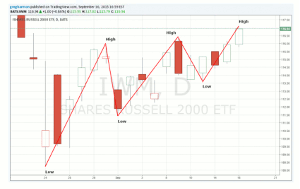Greg Harmon, of Dragonfly Capital, uses technical analysis to study the daily chart of the Russell 2000 ETF and explains that the best answer he has come up with is that traders and investors are human and cannot—try as they might—separate the pure data from the emotion.
Why is it up for debate about whether a trend exists in markets, and if it does, the direction? Shouldn’t these things be clear cut or at least defined by rules? On the surface the answer to why there are opinions about the same data can be attributed to differences in time frame. An investor that has a long horizon will not see the bumps in the road that a short-term trader will. But that does not explain why there are differences of opinion at major turning points.
The biggest turning point in recent history was the March 2009 low. And even giving the benefit of the doubt to some longer-term investors, there was still debate about if an uptrend was in play years later. Doesn’t this seem insane? There has to be more than time frame involved.
Fast forward to late August 2015. In the chart below is the daily activity for the Russell 2000 ETF (IWM). It made a low on August 24. Then it moved higher to August 31. Next a move lower to September 1. This made a higher low. The next move was to a higher high on September 9. Following came a higher low on the 11th and now Wednesday a higher high.
A series of higher lows and higher highs defines an uptrend. So why are there no prognosticators spewing forth that a new uptrend has begun? Well, again, we can give the long-term investors a pass for now as these are just short-term data. But the loud crowd are the short-term traders and even day traders. And for them this should be seen as an uptrend.
The best answer I can come up with is that traders and investors are human. They cannot, try as they might, separate the pure data from the emotion. In the case of March 2009 it was the fear and panic of a 40% pullback. Three weeks ago it was the fear of a 10% pullback. There has been memory created by these moves lower and they will not be soon forgotten.
This plays a role in the itchy trigger finger responses at the first sign of weakness. How soon until it goes away? I have no idea. But the important piece of information to take away from this is that it exists. Know that as you trade or invest there are memories of deep losses that cloud your and others thoughts.
By Greg Harmon of Dragonfly Capital



















